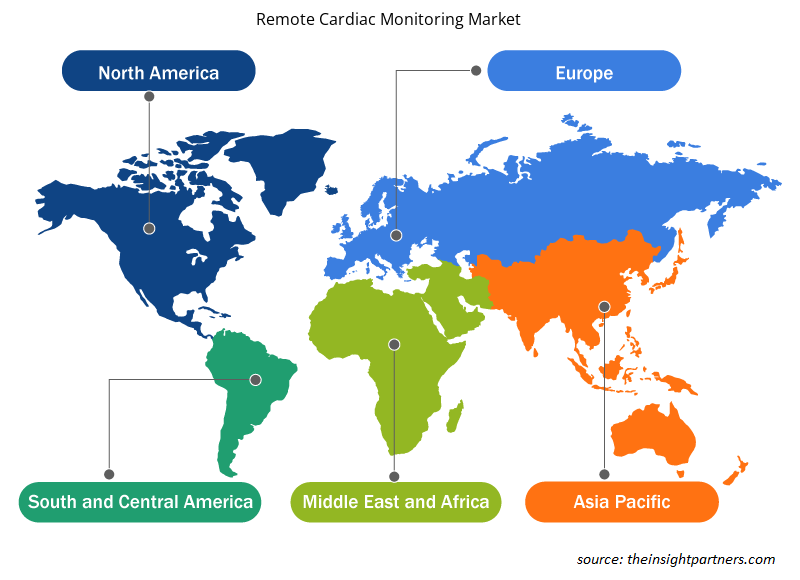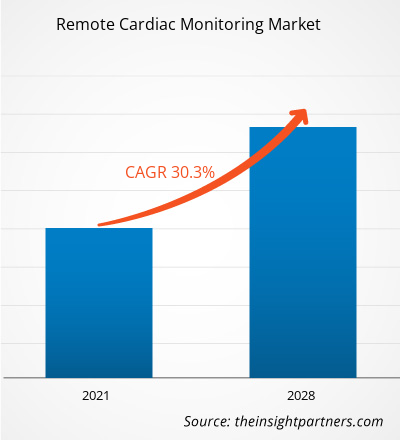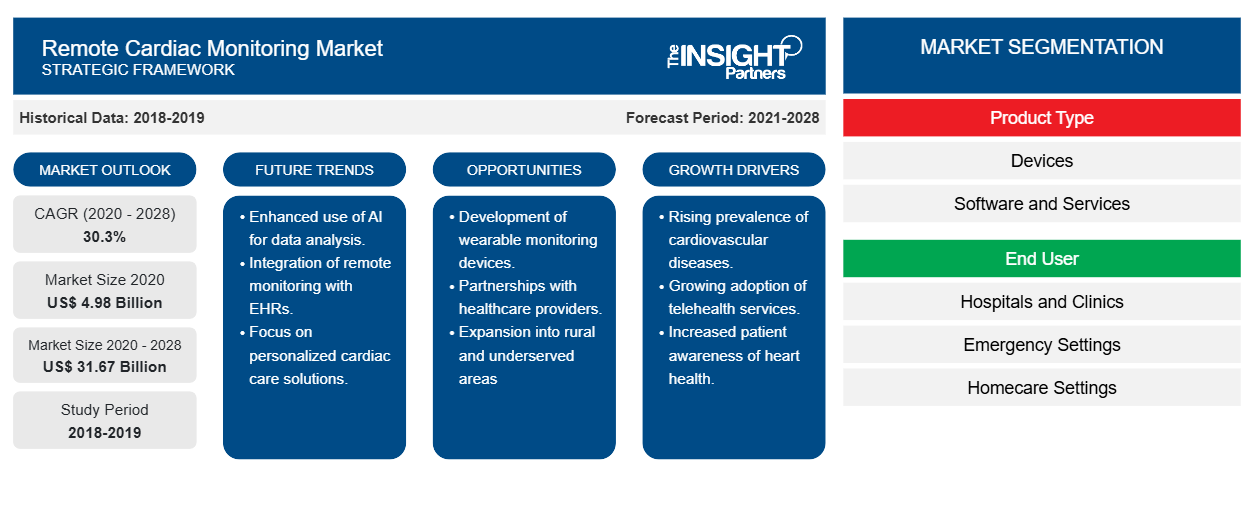من المتوقع أن يصل سوق مراقبة القلب عن بعد إلى 31،671.69 مليون دولار أمريكي بحلول عام 2028 من 4،976.40 مليون دولار أمريكي في عام 2021؛ ومن المتوقع أن ينمو بمعدل نمو سنوي مركب قدره 30.3٪ من عام 2021 إلى عام 2028.
تتيح أجهزة مراقبة القلب عن بعد مراقبة مستمرة للأنشطة الكهربائية للقلب بعيدًا عن المستشفيات. كما تسمح بمراقبة تخطيط القلب في المنزل للمرضى الذين يُشتبه في إصابتهم باضطرابات نظم القلب أو المعرضين لخطر الإصابة باضطرابات نظم القلب. يمكن أيضًا إجراء المراقبة عندما يكون المرضى منغمسين في أنشطتهم اليومية. وبالتالي، فإن إحدى أهم فوائد مراقبة أجهزة القلب عن بعد هي أنها تقلل من الحاجة إلى زيارات الطبيب الروتينية. يتم زرع أجهزة مثل أجهزة تنظيم ضربات القلب وجهاز تنظيم ضربات القلب القابل للزرع في قلب المرضى من خلال إجراءات طفيفة التوغل. يتولى جهاز إرسال يعمل في مزامنة مع الجهاز نقل البيانات. تعمل عوامل مثل زيادة حالات الإصابة بأمراض القلب والأوعية الدموية والتطورات المستمرة في نهج الطب عن بعد على تعزيز نمو سوق مراقبة القلب عن بعد . ومع ذلك، فإن المخاوف بشأن خصوصية البيانات تعيق نمو السوق.
قم بتخصيص هذا التقرير ليناسب متطلباتك
ستحصل على تخصيص لأي تقرير - مجانًا - بما في ذلك أجزاء من هذا التقرير، أو تحليل على مستوى الدولة، وحزمة بيانات Excel، بالإضافة إلى الاستفادة من العروض والخصومات الرائعة للشركات الناشئة والجامعات
-
احصل على أهم اتجاهات السوق الرئيسية لهذا التقرير.ستتضمن هذه العينة المجانية تحليلاً للبيانات، بدءًا من اتجاهات السوق وحتى التقديرات والتوقعات.
رؤى السوق
ارتفاع حالات الإصابة بأمراض القلب والأوعية الدموية
تتيح مراقبة المريض عن بعد للمرضى إدارة صحتهم بشكل أفضل من خلال زيادة مشاركتهم في الرعاية الصحية الخاصة بهم. تدعم جمعية القلب الأمريكية المبادرات الرامية إلى تحفيز تصميم واستخدام تقنيات مراقبة المريض عن بعد القائمة على الأدلة. وفقًا لمنظمة الصحة العالمية، تعد أمراض القلب والأوعية الدموية من بين الأسباب الرئيسية للوفاة في جميع أنحاء العالم، ويعاني حوالي 30 مليون شخص من السكتة الدماغية كل عام. وفقًا لجمعية القلب الأمريكية، يعاني ما يقرب من نصف جميع البالغين في الولايات المتحدة من نوع من أمراض القلب والأوعية الدموية. علاوة على ذلك، من المتوقع أن يعاني أكثر من 130 مليون شخص، أي 45.1٪ من سكان الولايات المتحدة، من نوع من أمراض القلب والأوعية الدموية بحلول عام 2035. وفقًا لتقارير الجمعية الأوروبية لأمراض القلب، تسبب أمراض القلب والأوعية الدموية 3.9 مليون حالة وفاة في أوروبا وأكثر من 1.8 مليون حالة وفاة في الاتحاد الأوروبي. علاوة على ذلك، فإنها تمثل 45٪ من جميع الوفيات في أوروبا و37٪ من إجمالي الوفيات في الاتحاد الأوروبي. وتتراوح معدلات الوفيات الناجمة عن أمراض القلب والأوعية الدموية في بلدان آسيا والمحيط الهادئ من أقل من 20% في بلدان مثل تايلاند والفلبين وإندونيسيا إلى 20-30% في المناطق الحضرية في الصين وهونج كونج واليابان وكوريا وماليزيا. وعلاوة على ذلك، فإن معدلات الوفيات الناجمة عن أمراض القلب والأوعية الدموية في نيوزيلندا وأستراليا وسنغافورة، من بين بلدان أخرى، مرتفعة نسبيا، حيث تتراوح بين 30-35%.
ارتفاع ضغط الدم هو عامل خطر كبير لأمراض القلب والأوعية الدموية. يبلغ معدل انتشار ارتفاع ضغط الدم المعدل حسب العمر بين البالغين في الولايات المتحدة حوالي 35٪، وهو ما يعادل عدد السكان البالغ حوالي 85 مليون نسمة. وبحلول عام 2035، سيكون حوالي 42٪ من البالغين في البلاد، أي 27 مليونًا إضافيًا، مصابين بهذه الحالة. كما يرتفع عبء تكاليف ارتفاع ضغط الدم على الاقتصادات، ومن المرجح أن ترتفع التكاليف من حوالي 70 مليار دولار أمريكي في عام 2015 إلى حوالي 150 مليار دولار أمريكي بحلول عام 2035. قد تعمل مراقبة المريض عن بعد كقناة حيوية لتحسين السيطرة على ارتفاع ضغط الدم وتقليل العبء الاقتصادي الناجم عن الإقامة الطويلة أو المتكررة في المستشفى الناتجة عن الأحداث الحادة المرتبطة بارتفاع ضغط الدم. أظهرت الأبحاث أن (مراقبة المريض عن بعد) RPM يمكن أن تخفض بشكل كبير ضغط الدم الانقباضي (SBP) وضغط الدم الانبساطي (DBP) مقارنة بالرعاية المعتادة والمراقبة الذاتية وحدها. وفقًا لبعض التجارب غير العشوائية، يمكن لأجهزة RPM تحسين النتائج من خلال تمكين الكشف الدقيق والمبكر بالإضافة إلى تقليل معدلات الوفيات الناجمة عن جميع الأسباب والاستشفاء. توصي الإرشادات السريرية الحديثة بشدة باستخدام RPM للكشف عن الرجفان الأذيني (AF) في كل من مرضى السكتة الدماغية وغير المصابين بالسكتة الدماغية.
رؤى تعتمد على نوع المنتج
بناءً على نوع المنتج، يتم تقسيم سوق مراقبة القلب عن بعد إلى أجهزة وبرامج وخدمات. احتل قطاع الأجهزة حصة سوقية أكبر في عام 2021 ومن المتوقع أن يسجل معدل نمو سنوي مركب أعلى خلال الفترة المتوقعة.
رؤى تعتمد على المستخدم النهائي
بناءً على المستخدم النهائي، يتم تقسيم سوق مراقبة القلب عن بعد إلى المستشفيات والعيادات، وأماكن الطوارئ، وأماكن الرعاية المنزلية، وغيرها. من المتوقع أن يستحوذ قطاع المستشفيات والعيادات على أكبر حصة سوقية في عام 2021، في حين من المتوقع أن ينمو سوق قطاع أماكن الطوارئ بمعدل نمو سنوي مركب يبلغ 31.60% خلال الفترة المتوقعة.
تتبنى العديد من الشركات العاملة في سوق مراقبة القلب عن بعد استراتيجيات مثل إطلاق المنتجات، والاندماجات والاستحواذات، والتعاون، وابتكارات المنتجات، وتوسيع محفظة المنتجات لتوسيع بصمتها في جميع أنحاء العالم، والحفاظ على اسم العلامة التجارية، وتلبية الطلب المتزايد من المستخدمين النهائيين.
رؤى إقليمية حول سوق مراقبة القلب عن بعد
لقد قام المحللون في Insight Partners بشرح الاتجاهات والعوامل الإقليمية المؤثرة على سوق مراقبة القلب عن بعد طوال فترة التوقعات بشكل شامل. يناقش هذا القسم أيضًا قطاعات سوق مراقبة القلب عن بعد والجغرافيا في جميع أنحاء أمريكا الشمالية وأوروبا ومنطقة آسيا والمحيط الهادئ والشرق الأوسط وأفريقيا وأمريكا الجنوبية والوسطى.

- احصل على البيانات الإقليمية المحددة لسوق مراقبة القلب عن بعد
نطاق تقرير سوق مراقبة القلب عن بعد
| سمة التقرير | تفاصيل |
|---|---|
| حجم السوق في عام 2020 | 4.98 مليار دولار أمريكي |
| حجم السوق بحلول عام 2028 | 31.67 مليار دولار أمريكي |
| معدل النمو السنوي المركب العالمي (2020 - 2028) | 30.3% |
| البيانات التاريخية | 2018-2019 |
| فترة التنبؤ | 2021-2028 |
| القطاعات المغطاة |
حسب نوع المنتج
|
| المناطق والدول المغطاة |
أمريكا الشمالية
|
| قادة السوق وملفات تعريف الشركات الرئيسية |
|
كثافة اللاعبين في السوق: فهم تأثيرها على ديناميكيات الأعمال
يشهد سوق مراقبة القلب عن بعد نموًا سريعًا، مدفوعًا بالطلب المتزايد من المستخدم النهائي بسبب عوامل مثل تفضيلات المستهلكين المتطورة والتقدم التكنولوجي والوعي المتزايد بفوائد المنتج. ومع ارتفاع الطلب، تعمل الشركات على توسيع عروضها والابتكار لتلبية احتياجات المستهلكين والاستفادة من الاتجاهات الناشئة، مما يؤدي إلى زيادة نمو السوق.
تشير كثافة اللاعبين في السوق إلى توزيع الشركات أو المؤسسات العاملة في سوق أو صناعة معينة. وهي تشير إلى عدد المنافسين (اللاعبين في السوق) الموجودين في مساحة سوق معينة نسبة إلى حجمها أو قيمتها السوقية الإجمالية.
الشركات الرئيسية العاملة في سوق مراقبة القلب عن بعد هي:
- شركة OSI Systems، المحدودة
- جنرال إلكتريك للرعاية الصحية
- بيوترونيك اس اي
- شركة نيهون كوهدن
- مختبرات أبوت
إخلاء المسؤولية : الشركات المذكورة أعلاه ليست مرتبة بأي ترتيب معين.

- احصل على نظرة عامة على أهم اللاعبين الرئيسيين في سوق مراقبة القلب عن بعد
سوق مراقبة القلب عن بعد – حسب نوع المنتج
- الأجهزة
- برمجة
- خدمات
سوق مراقبة القلب عن بعد – حسب المستخدم النهائي
- المستشفيات والعيادات
- إعدادات الطوارئ
- إعدادات الرعاية المنزلية
- آحرون
سوق مراقبة القلب عن بعد – حسب المنطقة الجغرافية
-
أمريكا الشمالية
- نحن
- كندا
- المكسيك
-
أوروبا
- فرنسا
- ألمانيا
- إيطاليا
- المملكة المتحدة
- إسبانيا
- بقية أوروبا
-
آسيا والمحيط الهادئ (APAC)
- الصين
- الهند
- كوريا الجنوبية
- اليابان
- أستراليا
- بقية آسيا والمحيط الهادئ
-
الشرق الأوسط وأفريقيا
- جنوب أفريقيا
- المملكة العربية السعودية
- الامارات العربية المتحدة
- بقية الشرق الأوسط وأفريقيا
-
أمريكا الجنوبية والوسطى (احتيال)
- البرازيل
- الأرجنتين
- بقية أمريكا الجنوبية والوسطى
ملفات تعريف الشركة
- شركة OSI Systems، المحدودة
- جنرال إلكتريك للرعاية الصحية
- بيوترونيك اس اي
- شركة نيهون كوهدن
- مختبرات أبوت
- شركة بوسطن العلمية
- شركة فيليبس الملكية
- شركة هونيويل الدولية
- مركز أيه إم سي الصحي
- التحليل التاريخي (سنتان)، سنة الأساس، التوقعات (7 سنوات) مع معدل النمو السنوي المركب
- تحليل PEST و SWOT
- حجم السوق والقيمة / الحجم - عالمي، إقليمي، بلد
- الصناعة والمنافسة
- مجموعة بيانات إكسل
التقارير الحديثة
شهادات العملاء
سبب الشراء
- اتخاذ قرارات مدروسة
- فهم ديناميكيات السوق
- تحليل المنافسة
- رؤى العملاء
- توقعات السوق
- تخفيف المخاطر
- التخطيط الاستراتيجي
- مبررات الاستثمار
- تحديد الأسواق الناشئة
- تحسين استراتيجيات التسويق
- تعزيز الكفاءة التشغيلية
- مواكبة التوجهات التنظيمية























 احصل على عينة مجانية ل - سوق مراقبة القلب عن بعد
احصل على عينة مجانية ل - سوق مراقبة القلب عن بعد